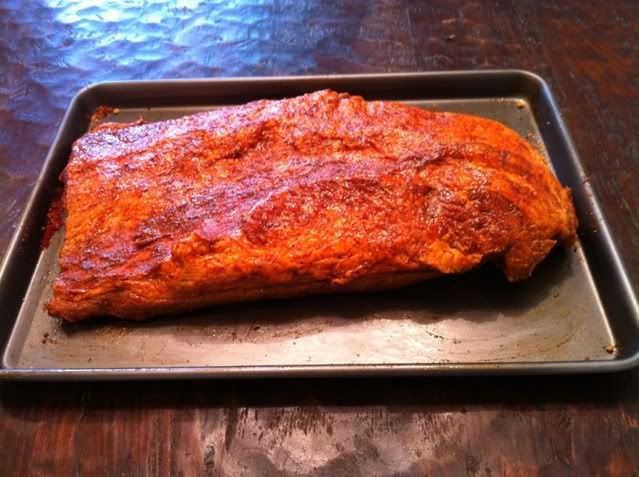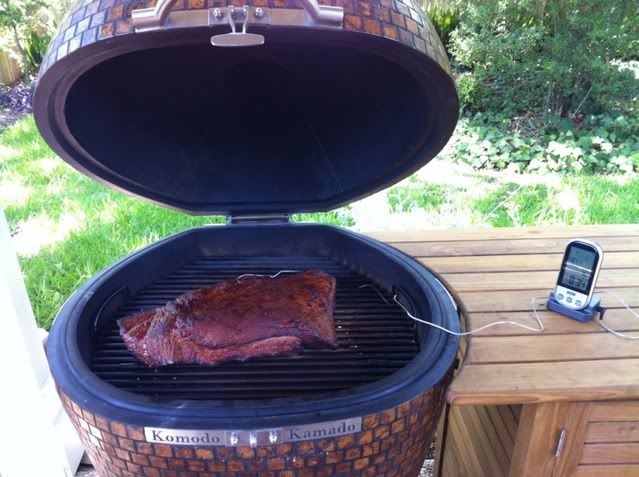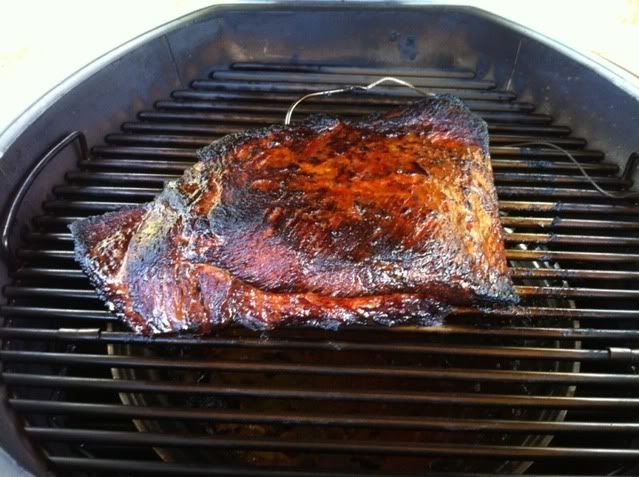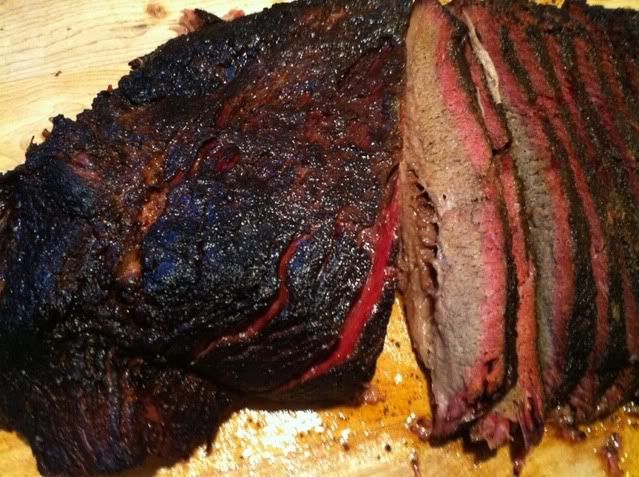Re: High Heat Brisket
Originally posted by MR. COSELL:
Everybody should pslost what they know about bbq and the high heat method and the mods should ARCHIVE this thread with the other bbq thread.
Here's the method I'm following. The guy on this forum had a great post. Chances are, he's probably an OB member based on his avatar for that site.
Method
**Summary
- Prepare brisket, trimming fat a little more than usual.
- Apply a wet rub followed by a dry.
- Fire the WSM using the Minion method, with 3/4 of a chimney of charcoal and all smoke wood on top.
- Put the brisket on as the WSM is heating up. Target a lid temperature of 325 to 350.
- Flip the door and crack it open as an additional air source if needed to get the temperature up.
- Cook the brisket to an internal temperature of about 170, just past plateau.
- Foil the brisket loosely, but with a tight crimp. If you are removing the point, do that now, and don't foil the point.
- Continue to cook, but not by temperature. Remove the meat when the flat is just probe tender.
- Remove brisket from foil and carefully reserve all liquid.
- If you are firming the bark, return the meat to the smoker, directly on the grate for 30 minutes.
- Rewrap in new foil, adding about 1 1/2 cups of reserved liquid to the flat, and rest in towels in a cooler for 30 min to 3 hours.
**Select and Trim Brisket
Note: if you are well organized, you can fire up the chimney for the WSM before trimming and applying the rubs. Or between trimming and applying the rubs.
This method can be used on just the flat, but most folks seem to be doing whole packers. This method most commonly recommended for Select and no-roll (ungraded) briskets since they don't have the marbling that Choice or other higher end branded briskets do. Traditional low and slow is still recommended for these higher end briskets.
Trim the fat from a packer a little more than usual. Keep the fat cap trimmed to about 1/4 inch, but don't remove it. The brisket will be cooked fat-side down to protect the meat from the higher heat. The reason for the higher trim is that the shorter cooking time will not allow it to render down like it does when cooked low/slow.
**Prepare and Apply Rubs
Because the brisket is finished in foil, you won't get a hard bark. There are two levels of technique for dealing with this. First, use a wet paste rub followed by a dry rub for all high heat method briskets. The paste will set up and be similar to bark, but will be a bit moist. Second, if you want to try for a drier, more traditional bark, return the brisket to the smoker uncovered for the last 30 minutes in order to firm up the outside.
For Kevin's Paste Rub, use a blender to puree all the ingredients except the oil until very smooth. Then, with the machine running, add the oil in a slow stream. The paste recipe is enough to cover a whole 12-14-pound packer with the exception of the fatcap side.
For Kevin's Dry Rub, Using your spice grinder of choice, combine all ingredients and grind together. If some or any of the spices are in whole form (cloves, fennel, coriander, cardamom seeds, white peppercorns, black peppercorns), toast them, if desired, in a dry pan heated over high heat stirring constantly, until very fragrant, about 1 min. The dry recipe will make more than you need.
Craig Castille's paste rub is also shown.
If you plan to separate the point, you can insert a toothpick into the fat seam between the flat and point as a marker before you put on the rub . This will give you an idea where they join when it's time to seperate them.
Apply your paste with the back of a soup spoon to the brisket and spread it fairly evenly. Sprinkle the rub over the paste lightly, wait a few minutes, then sprinkle on more rub, as desired.
**Fire-Up The Cooker
Use an empty water pan. The water in a water pan is a heat sink, and does not add moisture to the meat. Since water boils at 212, using water as a sink will tend to hinder your ability to get the cooker to the mid 300s needed for the high heat method. Instead of water as a heat sink, use a 14" pottery flower pot base. The flowerpot base should just fit on top of your water pan. The empty water pan acts as an air insulator to prevent the flowerpot base from getting so hot it will burn the drippings and the water pan also supports the flowerpot base more securely than trying to hang the pottery off the tabs all by itself. Some folks recommend putting sand in the base before foiling to add additional mass and thus a larger heat sink. Line both the pan and pottery base with foil to make cleanup easier, to catch the drippings, and to keep fats from absorbing into the pottery.
Light the cooker using the Minion Method. Open all vents. Start with a full ring of briquettes. Don't skimp on the charcoal. If you end up with more fuel than needed, you can shut down the cooker after removing the meat to preserve the remaining coal for a future cook. Top with your smoke wood. Because the cook is faster, and since you will foil for the end, you want all of the smoke wood on top. This allows it to be consumed and add its flavor before foiling. Light a 3/4 filled chimney of briquettes spread them over the unlit briquettes and smoke wood chunks. Then wait until the ring feels real hot before assembling the unit (probably around 15 minutes). Expect it to take an hour or so to come up to the cook temperature.
High heat cooking is between 325 and 350 on the lid. To get to this temperature with the Minion method, you may need more air than the vents allow. Flipping the door upside down (so the knob is on the bottom) and propping it open 1/2 to 1 inch is usually all you need to boost temps. Use a piece of split wood to adjust the opening of the door. Unless the smoker is sitting in the direct sun light, expect to have to prop the door open. Sometimes the door stays propped open the entire cook. It ususally settles around 325-335 lid for the duration.
**Barbeque the Brisket
If you can time it such that the meat is going on as the Minion start is beginning, you can achieve a better smoke ring. Figure a packer taking 4-4.5 hours by this method.
Put the brisket on the grate fat side down. The fat layer helps protect the meat from the higher radiant heat. Cook until a probe inserted from the side into the flat reads 160 to 170 or so. This should be through he plateau.
Now remove the brisket to foil it. If you are going to separate the point, now is the time. The point can be cooked unfoiled on the grate next to the foiled flat to make outstanding burnt ends. Foil the brisket (or flat), fat cap UP, tenting and leaving room, but making sure it is crimped together tightly. The brisket will throw off a good deal of liquid. Having room around and above it will contain the liquid but lessen the pressure on the foil.
As an alternative to HD foil, consider a foil pan. These come in an 18" x 12" x 3" oval size that is an excellent fit on a WSM 18.5. Then foil over the brisket in the pan. This will allow much easier access for probing for doneness, and will make physically managing the liquid easier and safer.
Once foiled, use the probe to determine when the brisket is done, but NOT by temperature. Just prove vertically Abandon any notion of a targeted finish temperature. Especially because a foiled brisket will give artificially high temperatures. When the brisket hits the low 190s cook at the clock. If it's been over 90 min since you foiled but not quite 2 hours you'll likely need more time, 30-45 min, but check the brisket. Don't move it--check it where it is. If you're not using a foil pan, keep the crimp high to keep from losing liquid, uncrimp enough so that you can probe in a few places to feel the meat. (Note about how much liquid is in the foil, so you can select a proper sized container when it comes off.) Check in the usual center area, not the tip nor the point. It's OK to probe vertically. You want to probe to go in like it would in butter. If there's some resistance, remove the probe, reseal and cook another 30 min or so and check again.
Remember, too, that since you're cooking higher you'll get good residual cooking after pulling. And if you are returning the brisket unfoiled to firm the bark, you will get further cooking. There is more leeway, finish-wise, with briskets cooked this way--if you go 30 min but the brisket needed 15 no problem.
A 12-pounder will take between a bit over 2 hours to 2:40 in the foil.
When it is time to pull the foiled brisket, get your liquids container ready and new foil. You will have scoped out the liquid quantity situation the first time you checked. If it seemed scant (not likely) have some chicken stock (or beef) ready. Carefully lift off the package and drain the juices into the container. You could have as much as 3 cups so be prepared.
Now you have a choice. If you want to firm up the bark, return the brisket unfoiled to the smoker for about 30 minutes.
**Resting
When you are finally done cooking, wrap anew in doubled foil (or foil pan) and stick a good 1 1/2 cups of liquid back in there, unseparated. Separate and de-fat the remainder, if desired, for sauce.
If you need to reduce excessive residual cooking, rest the brisket in opened foil on the counter or on top of the cooler for 5-10 minutes.
Seal tightly, wrap in towels and rest in the vessel of your choice. Rest for an absolute minimum of 30 minutes, or a typical 1 to 2 hours. Towel wrapped and stored in a cooler, the brisket can be held for 3 hours or more, as long as the temperature does not drop below 140.
**Storing Leftovers
Brisket tastes great as leftovers, and it can be refrigerated safely for 3-4 days. The bark on brisket gets soft during storage and reheating. But the high heat method did not generate a strong bark to begin with, so that is less of a concern. Take care to not dry it out during reheating. A good method is to take brisket in zip bags with as much air removed as possible, and reheat them in simmering water. This limits the maximum temperature to 200 or so.
Brisket freezes great in a zip bag (again, suck as much air out as possible). You can freeze chopped, sliced or unsliced. To reheat, you should thaw it first in the refrigerator. Then place the bag in simmering water until heated. You can take it straight from the freezer to simmering water until thawed and heated if you have to.
Notes
Questions, Todd D:
1) Trim or don't trim? I've read some that say trim more aggressively than usual for low slow. Have also read don't trim anything.
2) Previous briskets have used a little worcestershire and then the midnight brisket rub from the cooking section. Is that still acceptable on a HH cook, or do I need to move on and try a paste & rub combo?
3) Should I get the smoker up to temp before placing the 2 briskets on? Concerned that cold ambient temps (probably in the 30s) along with 2 packers could delay the time to get up to temp. I normally cook with a Stoker.
4) Should I swap briskets between top and bottom shelves when pulling out to foil?
5) If resting in a towel lined cooler for an hour to two, would you return to fat side up during that rest?
6) Is there much fat trimming that needs to be done after a HH brisket? Normally I have very little left on a low slow
7) When probing for done, are you probing perpendicular to the meat, or coming in horizontally from the end?
Answers, Craig Castille:
1) I only trim in the cavity between the flat and the point. All else stays on until the end
2) experiment with what you like. I use a paste as it adds a crusty flavor. Bark is a casualty of HH cooks.
3) I'd get the fuel very engaged before assembly and putting the meat on. Once assembled, I'll leave the door off until temps get to 400. Then I'll play with the door or lid to maintain temps.
4) Probably a good idea.
5) I wouldn't turn it upside down if you use a paste. Keep in mind that the brisket will continue to cook if it's in a cooler. If you want to hold it for a couple of hours, then take it off just before tender or you may end up with pot roast.
6) Fat depends on the brisket It's easier to remove after cooking.
7) To check for tenderness, I insert the probe from the side.
Answers, Kevin Kruger:
1. I only trim the fat, some, in the cavity, like craig. Often I don't even do that. Depends on the brisket.
2. I use a dry over paste. I like depth and breadth.
3. I always Minion the start, using twice as much lit. In cold ambient temps I just up the lit. I prefer to have the meat cold and the cooker cold when I start. On virtually no cooks do I bring the cooktemp up first.
4. I do.
5. I don't. I don't cooler either. I rest 20-30 on the counter after draining most of the foil juices.
6. I usually go with perpendicular, un the middles of the flat (not the middle of the packer).
TVWBBQ Forum






